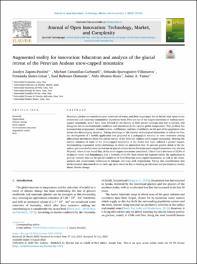| dc.contributor.author | Zapata-Paulini, Joselyn | |
| dc.contributor.author | Cabanillas-Carbonell, Michael | |
| dc.contributor.author | Iparraguirre-Villanueva, Orlando | |
| dc.contributor.author | Sierra-Liñan, Fernando | |
| dc.contributor.author | Baltozar-Clemente, Saul | |
| dc.contributor.author | Alvarez-Risco, Aldo | |
| dc.contributor.author | Yáñez, Jaime A. | |
| dc.date.accessioned | 2023-10-18T20:46:22Z | |
| dc.date.available | 2023-10-18T20:46:22Z | |
| dc.date.issued | 2023-09 | |
| dc.identifier.uri | https://hdl.handle.net/20.500.13053/9594 | |
| dc.description.abstract | Mountain glaciers are considered great reservoirs of water, and their importance lies in the fact that many of our ecosystems and numerous communities depend on them; Peru has one of the largest extensions of Andean snow-capped mountains, which have been affected by the decline in their glacier coverage and that is warned, will disappear due to environmental conditions and alterations in the current global temperature. This problem has increased due to ignorance, misinformation, indifference, and lack of solidarity on the part of the population who favors this discouraging situation. Taking advantage of the current technological immersion, in which we live, the development of a mobile application was proposed as a pedagogical resource to raise awareness among educational institutions about the glacial retreat of the Peruvian Andean snow-capped mountains, showing the current situation of some of the snow-capped mountains of the Andes that have suffered a greater impact, implementing augmented reality technology to obtain an interactive link. To provide greater detail of the situation, previous studies were carried out on glacial retreats in two Peruvian snow-capped mountains over the last 40 years, where it was found that, of the snow-capped mountains considered, Chicon had a decrease of 32.5% of its glacier cover, and Pumahuanca had a decrease of 56.9%. Such results are exposed within the application to provide realistic data on the glacial conditions of both Peruvian snow-capped mountains, as well as the consequences and conservation techniques to mitigate and cope with deglaciation. Taking into consideration that environmental education from an early age turns out to be key to forming an informed and participatory society about climate change. | es_PE |
| dc.format | application/pdf | es_PE |
| dc.language.iso | eng | es_PE |
| dc.publisher | Elsevier B.V. | es_PE |
| dc.rights | info:eu-repo/semantics/openAccess | es_PE |
| dc.rights.uri | https://creativecommons.org/licenses/by/4.0/ | es_PE |
| dc.subject | "DeglaciationClimate changeSnow-cappedEnvironmental educationAugmented realityPeru " | es_PE |
| dc.title | Augmented reality for innovation: Education and analysis of the glacial retreat of the Peruvian Andean snow-capped mountains | es_PE |
| dc.type | info:eu-repo/semantics/article | es_PE |
| dc.identifier.doi | 10.1016/j.joitmc.2023.100106 | |
| dc.type.version | info:eu-repo/semantics/publishedVersion | es_PE |
| dc.publisher.country | CHE | es_PE |
| dc.subject.ocde | 3.03.00 -- Ciencias de la salud | es_PE |


